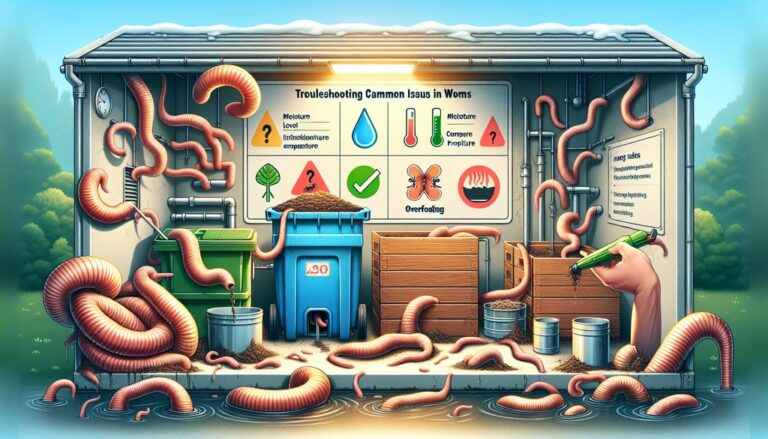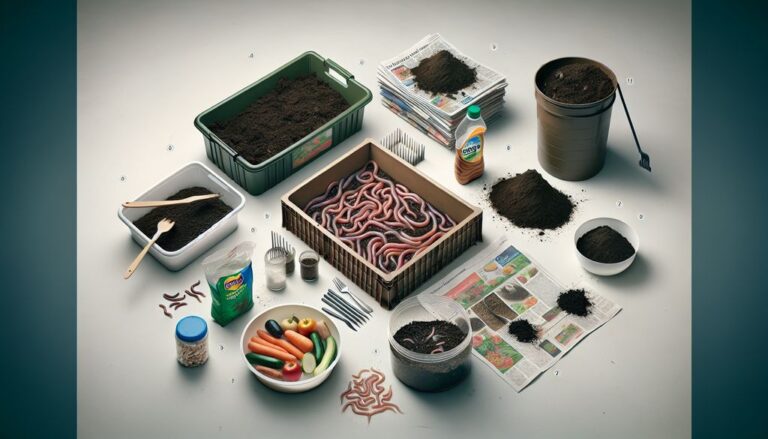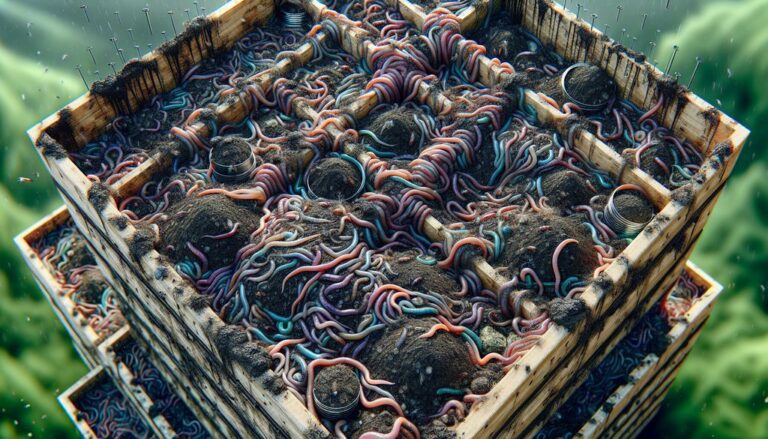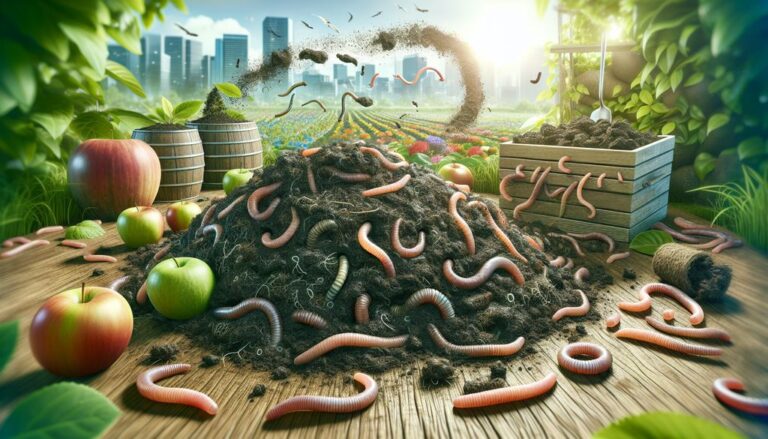Vermicompost, also known as worm castings, is a nutrient-rich organic fertilizer produced by earthworms. It is a valuable resource for gardeners and can be used in various creative ways to enhance plant growth and soil health. In this article, we will explore five innovative ways to use vermicompost, from garden soil enhancement to landscaping mulch. Let’s dive in and discover the potential of vermicompost in sustainable gardening practices!
Key Takeaways
- Vermicompost is a nutrient-rich organic fertilizer produced by earthworms.
- It can be used to enhance garden soil, improve potting mixes, top-dress lawns, create compost tea, and serve as mulch for landscaping.
- Vermicompost is a sustainable and eco-friendly alternative to chemical fertilizers.
- The use of vermicompost promotes soil health, enhances plant growth, and reduces environmental impact.
- By utilizing vermicompost, gardeners can contribute to a more sustainable and organic approach to gardening.
1. Garden Soil Enhancement
Vermicompost is a nutrient-rich, natural fertilizer that can significantly improve your garden soil. Incorporating vermicompost into your garden beds enhances soil structure, promotes healthy plant growth, and increases the soil’s water retention abilities.
To use vermicompost for garden soil enhancement, follow these simple steps:
- Spread a layer of vermicompost over your garden bed.
- Gently work it into the top few inches of soil.
- Plant your seeds or seedlings as usual.
Vermicompost is not only beneficial for your plants but also contributes to the overall health of your garden ecosystem by encouraging beneficial microbial activity.
Remember, a little goes a long way. Start with a thin layer of vermicompost and observe how your plants respond before adding more. This organic matter is a powerhouse of nutrients, and your garden will thank you for it.
2. Potting Mix Component
Vermicompost is an excellent addition to your potting mix, providing essential nutrients and improving soil structure for potted plants. Incorporate vermicompost into your potting soil to enhance plant growth and health. A general guideline is to mix one part vermicompost with three parts potting soil, but you can adjust this ratio based on the needs of specific plants.
- Potting Mix Recipe:
- 1 part vermicompost
- 3 parts potting soil
- Optional: Add perlite or vermiculite for extra aeration
By enriching your potting mix with vermicompost, you create a living soil that fosters a robust root system and vigorous plant development.
Remember, the key to successful container gardening is good drainage. Ensure your containers have adequate drainage holes to prevent waterlogging, which can harm plant roots. Vermicompost’s fine texture helps retain moisture while also allowing excess water to drain, striking the perfect balance for healthy plant growth.
3. Lawn Top-Dressing
Vermicompost can be an excellent top-dressing for your lawn, providing a boost of nutrients that can help improve soil health and grass vitality. Top-dressing with vermicompost can invigorate your lawn, giving it a lush, green appearance. Here’s how to use vermicompost as a lawn top-dressing:
- Step 1: Aerate your lawn to allow the vermicompost to penetrate the soil more effectively.
- Step 2: Spread a thin layer of vermicompost across the lawn. Aim for about a quarter-inch thickness.
- Step 3: Use a rake or a brush to work the vermicompost evenly into the grass.
- Step 4: Water your lawn lightly to help the vermicompost settle.
Remember, the key to successful top-dressing is to apply a thin, even layer of vermicompost. This ensures that your grass isn’t smothered and that the nutrients can reach the soil where they’re most needed.
By following these simple steps, you can make the most of your vermicompost and create a healthier environment for your lawn. Not only does this practice enrich the soil, but it also promotes better water retention and can reduce the need for chemical fertilizers.
4. Compost Tea
Compost tea is a nutrient-rich liquid solution made by steeping vermicompost in water. It’s an excellent way to provide your plants with a quick nutrient boost. This liquid fertilizer can be applied directly to the soil or used as a foliar spray, delivering essential nutrients to plants in a form that’s easily absorbed.
To make compost tea:
- Fill a bucket with water and add a handful of vermicompost.
- Stir the mixture and let it sit for 24-48 hours, allowing the nutrients to leach into the water.
- After steeping, strain the liquid to remove any solid particles.
- Dilute the compost tea with water until it’s the color of weak tea before applying to your plants.
Remember, the key to successful compost tea is aeration and balance. Without proper aeration, the tea can become anaerobic and potentially harm your plants.
Regular use of compost tea can help improve plant growth, increase resistance to disease, and enhance soil quality. It’s a sustainable and cost-effective method to make the most of your vermicompost while providing your garden with a plethora of benefits.
5. Mulch for Landscaping
Using vermicompost as mulch in your landscaping not only nourishes the soil but also retains moisture, suppresses weeds, and gives your garden beds a neat, finished look. Spread a layer of vermicompost around the base of your plants to create a barrier that enhances soil health and supports plant growth.
- Vermicompost mulch helps regulate soil temperature, protecting roots from extreme heat and cold.
- It introduces beneficial microorganisms that improve soil structure and nutrient availability.
- As it breaks down, it continues to feed the soil, reducing the need for additional fertilizers.
Vermicompost used as mulch is an excellent way to recycle nutrients back into the garden ecosystem, promoting a sustainable and healthy environment for your plants.
Remember to apply the vermicompost mulch gently around the plants, avoiding direct contact with the stems to prevent any potential rot. Replenish the mulch layer periodically to maintain its benefits throughout the growing season.
Conclusion
In conclusion, vermicompost is a versatile and sustainable way to enrich your garden and reduce waste. By using kitchen scraps, dry vegetables, eggshells, teabags, coffee granules, and grass cuttings, you can create nutrient-rich compost for your plants. Additionally, with the right composting methods, you can contribute to environmental conservation and create a healthier ecosystem. Whether it’s through DIY compost bins or wormeries, the possibilities are endless. So, start vermicomposting today and watch your garden thrive while minimizing your environmental impact.
Frequently Asked Questions
What is vermicompost?
Vermicompost is a nutrient-rich organic fertilizer and soil conditioner that is produced by composting organic waste with earthworms.
How long does it take to make vermicompost?
The time it takes to make vermicompost depends on various factors such as the type of organic waste, the number of earthworms, and the environmental conditions. Generally, it takes anywhere from 2 to 6 months.
Can vermicompost be used for indoor plants?
Yes, vermicompost is an excellent natural fertilizer for indoor plants. It provides essential nutrients and improves soil structure, promoting healthy plant growth.
Is vermicompost safe for vegetable gardens?
Yes, vermicompost is safe for vegetable gardens. It enriches the soil with nutrients and beneficial microorganisms, leading to healthier and more productive vegetable plants.
How often should vermicompost be applied to the soil?
Vermicompost can be applied to the soil every 3-4 weeks during the growing season. For established plants, a layer of vermicompost can be added to the soil surface once or twice a year.
Can vermicompost be used as a seed starting medium?
Yes, vermicompost can be used as a seed starting medium. Its fine texture and nutrient content make it an ideal medium for germinating seeds and supporting early seedling growth.






